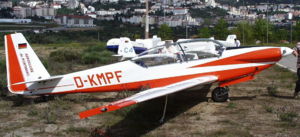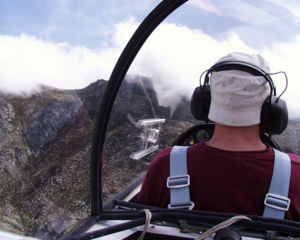PlaneSpottingWorld welcomes all new members! Please gives your ideas at the Terminal.
Fournier RF-5
| An RF-5 at Covilhã, Portugal. | |
| Type designation | RF-5 Sperber |
| Competition class | N/A |
| Number built | |
| Crew | 2 |
| Length | 7.71 m |
| Height | 1.96 m |
| Cockpit width | |
| Cockpit height | |
| Wingspan | 17.02 m |
| Wing area | 19.0 m² |
| Aspect ratio | 15.25 |
| Wing profile | NACA 23015/23012 |
| Empty mass | ca. 470 kg |
| Maximum mass | 680 kg |
| Wing loading | ca. 25 - 27 kg/m² |
| Maximum speed | 250 km/h (102 kts) |
| Rough air speed | |
| Stall speed | 60 km/h (37 kts) |
| Minimum sink rate | ca. 0.89 m/s |
| Powered climb rate | 3 m/s |
| Best glide ratio | 26 |
| In flight view from the back seat. | |
The Avion-Planeur series of powered sailplanes designed by René Fournier were manufactured by a succession of companies. Sportavia was formed in 1966 to take over production from Alpavia. In addition to the RF-5B Sperber (or Sparrowhawk), Sportavia build under licence the SF-25B and SF-25G Falke.
Construction of the prototype began in early 1971 and it first flew in May of that year. The RF5B received German certification in the motor glider category in March 1972, and by the spring of 1977 a total of 80 RF5Bs had been delivered; from 1979 it is only available to a firm order.
The RF-5B is a two-seat motor glider intended for initial training and soaring. It is an improved version of the RF-5 with the wing span increased from 13.75 m (45 ft 1 1/4 in) to 17.02 m (55 ft 10 in) and the rear fuselage cut down to reduce side area and improve rearward visibility from the new bulged canopy. The wing is an all-wood single-spar structure with plywood and fabric covering. The outer wings can be folded by a quick-lock system to facilitate hangarage. The fuselage is an all-wood oval section structure of bulkheads and stringers covered with a plywood skin and the two pilots sit in tandem beneath a one-piece Plexiglas canopy hinged sideways. There is space for 5 kg (11 lb) of baggage behind the rear seat.
In 1973 several modifications were introduced on production aircraft including an improved cabin heating system; an engine muffler to decrease exterior and cabin noise levels; an adjustable ventilation system; optional disc brakes and a wider range of instrument and equipment optional 'extras', which now include an artificial horizon, electric compass and a flight data computer.
The same 68hp Sportavia-Limbach SL 1700E Comet engine as on the RF5 is fitted, although the SL 1700E1 of the same horsepower can be fitted optionally, this variant being equipped to drive the Hoffman HO-V62R two-blade three-position variable-pitch propeller that is available as an alternative to the fixed-pitch prop. All fuel is now contained in a single fuselage fuel tank of 32.5 litres capacity. The RF55, which first flew in 1972, was a modified version of the RFSB fitted with a slightly-modified 60hp Franklin 2A-120-A engine to meet overseas certification requirements; an electric fuel pump was featured, as well as a larger fuel tank; this version did not go into production.
Sources
Lists relating to aviation | |
|---|---|
| General | Timeline of aviation · Aircraft · Aircraft manufacturers · Aircraft engines · Aircraft engine manufacturers · Airports · Airlines |
| Military | Air forces · Aircraft weapons · Missiles · Unmanned aerial vehicles (UAVs) · Experimental aircraft |
| Notable incidents and accidents | Military aviation · Airliners · General aviation · Famous aviation-related deaths |
| Records | Flight airspeed record · Flight distance record · Flight altitude record · Flight endurance record · Most produced aircraft |


